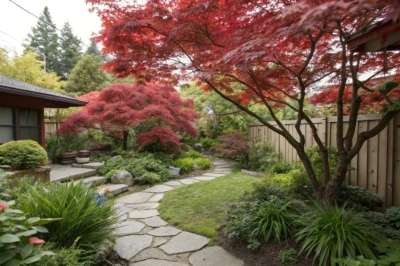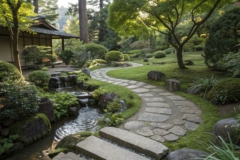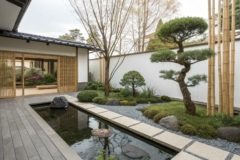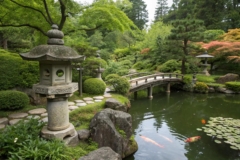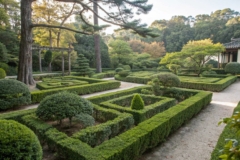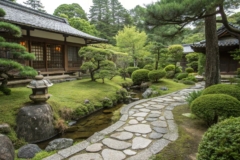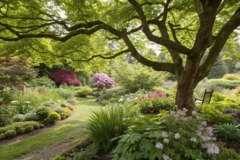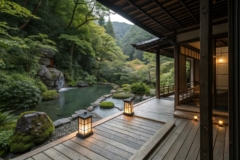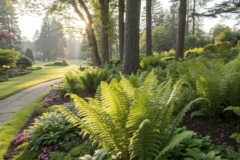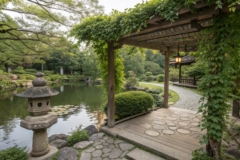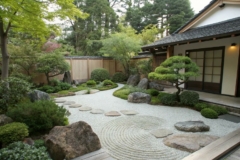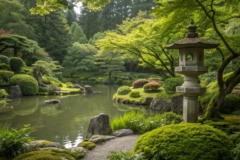1. Japanese Maple Arboretum
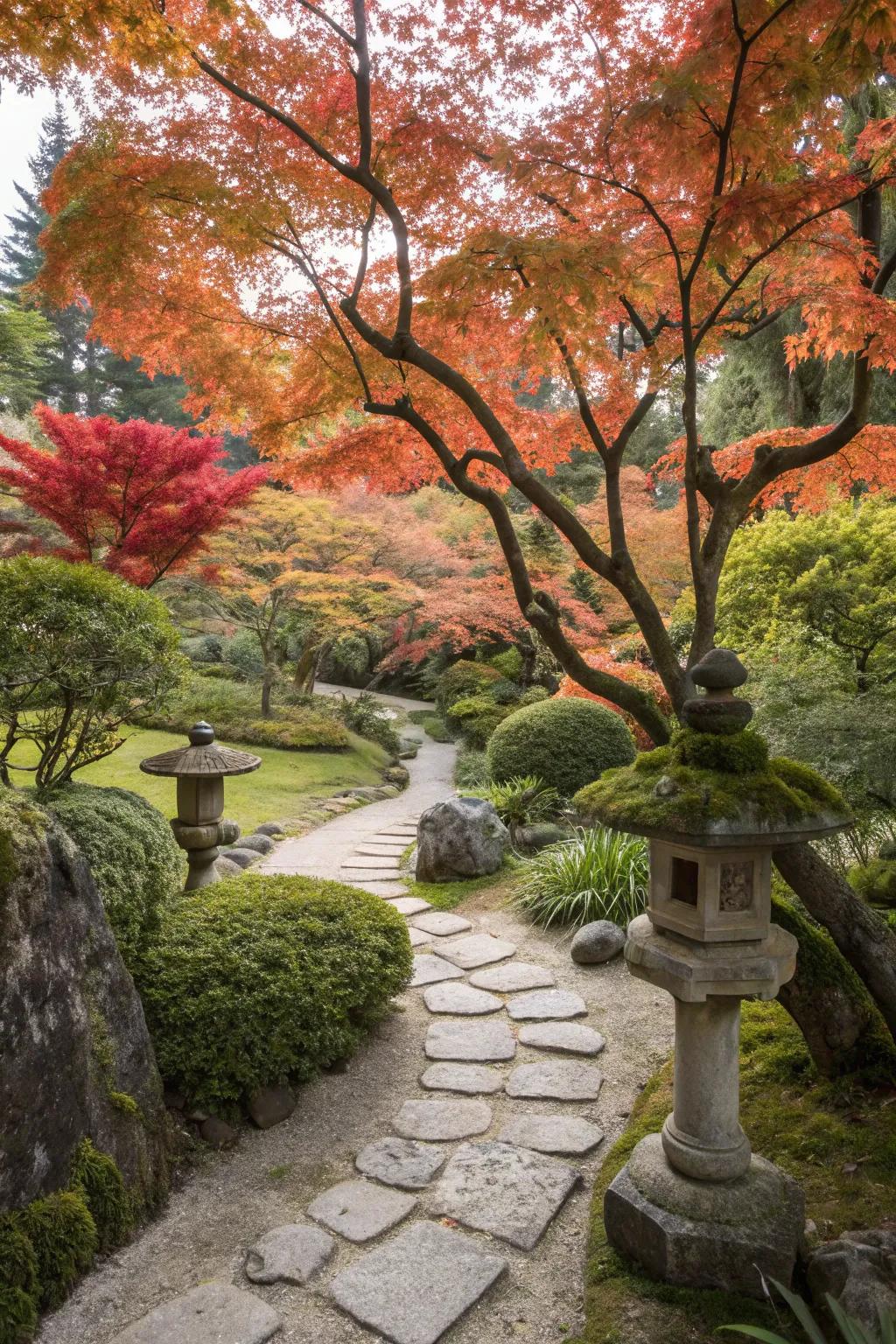
Create a mini arboretum by dedicating a section of your garden to Japanese maples. This area becomes a special place to relax and admire nature’s artistry.
Maybe worth checking out:
- Stone Garden Lantern: Enhance ambiance with a tranquil garden lantern, adding elegance to your Japanese maple arboretum.
- Garden Stepping Stones: Create a serene walkway with stepping stones, inviting calmness in your arboretum space.
- Outdoor Bench: Add a cozy seating area to relax and admire your beautiful Japanese maples.
2. Highlighting Architectural Features
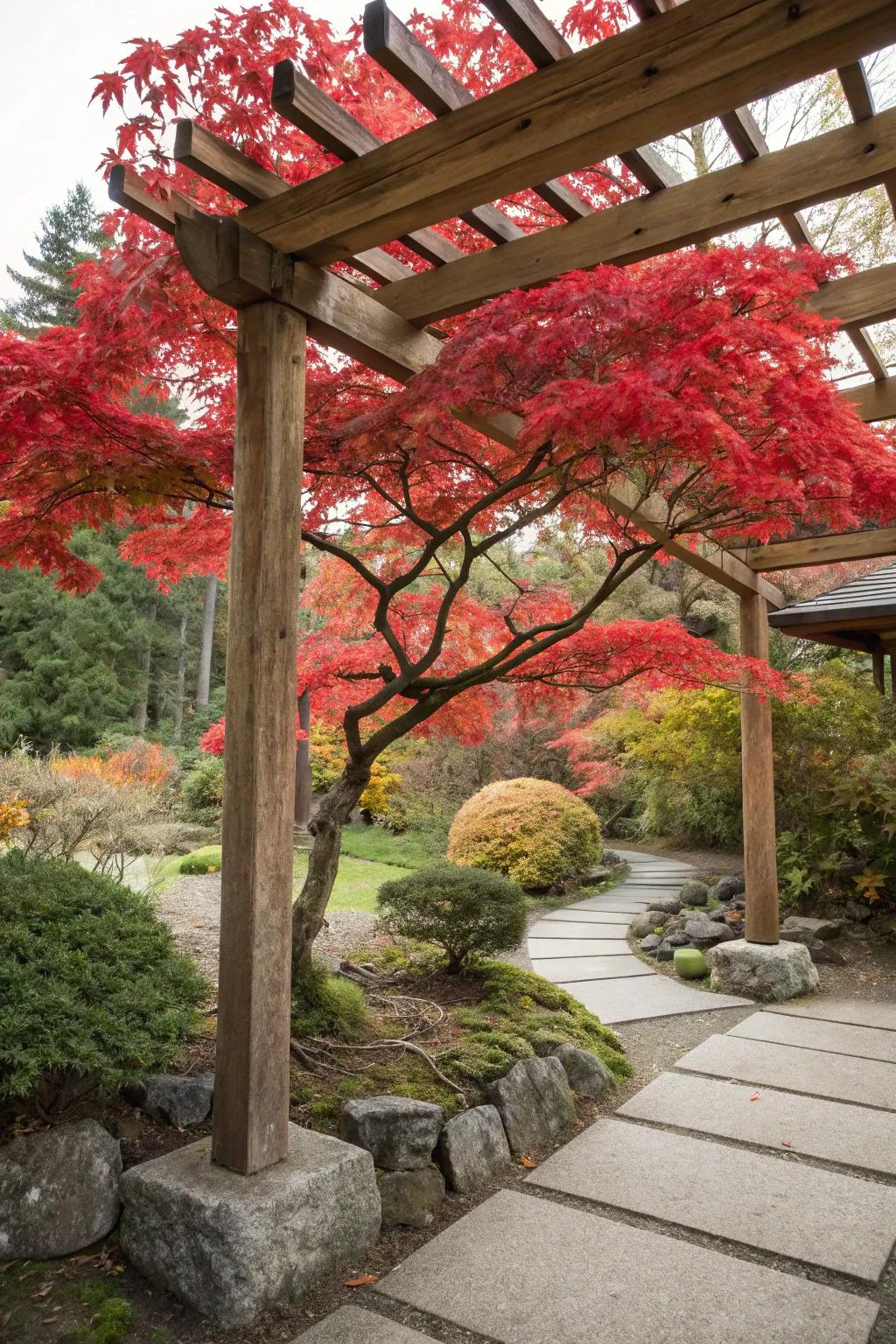
Place Japanese maples near architectural features to draw attention to them. This trick works wonders in my garden, adding visual interest and charm.
These products might help:
- Outdoor LED Spotlight: Illuminate your Japanese maple at night, creating a stunning focal point in your garden.
- Decorative Garden Edging Stones: Define pathways and highlight features with these stylish and durable garden edging stones.
- Garden Pergola Kit: Install a pergola to complement your Japanese maple, adding structure and elegance to your garden.
3. A Front Yard Statement
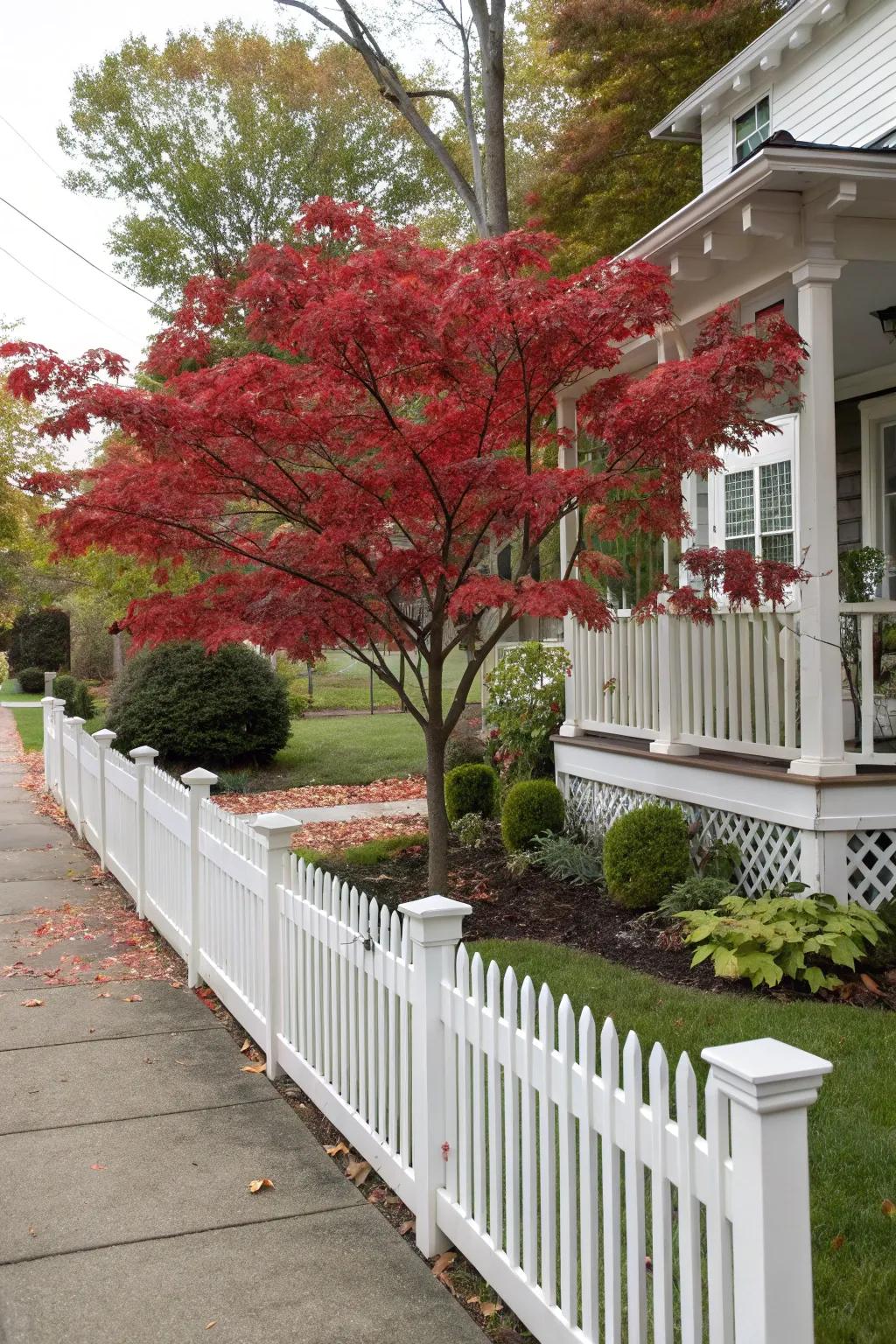
A single Japanese maple can turn your front yard into a stunning focal point. I love planting them near the entrance for a warm welcome that elevates curb appeal.
You might like:
- Decorative Garden Edging Fence: Define your garden perimeter stylishly, enhancing curb appeal with charming decorative fence lines.
- Outdoor Solar Landscape Lights: Illuminate your Japanese maple at night, creating an enchanting evening ambiance effortlessly.
- Mulch for Garden Trees: Protect and nourish your Japanese maple with rich mulch, promoting beautiful, healthy growth.
4. Complementing Color Schemes
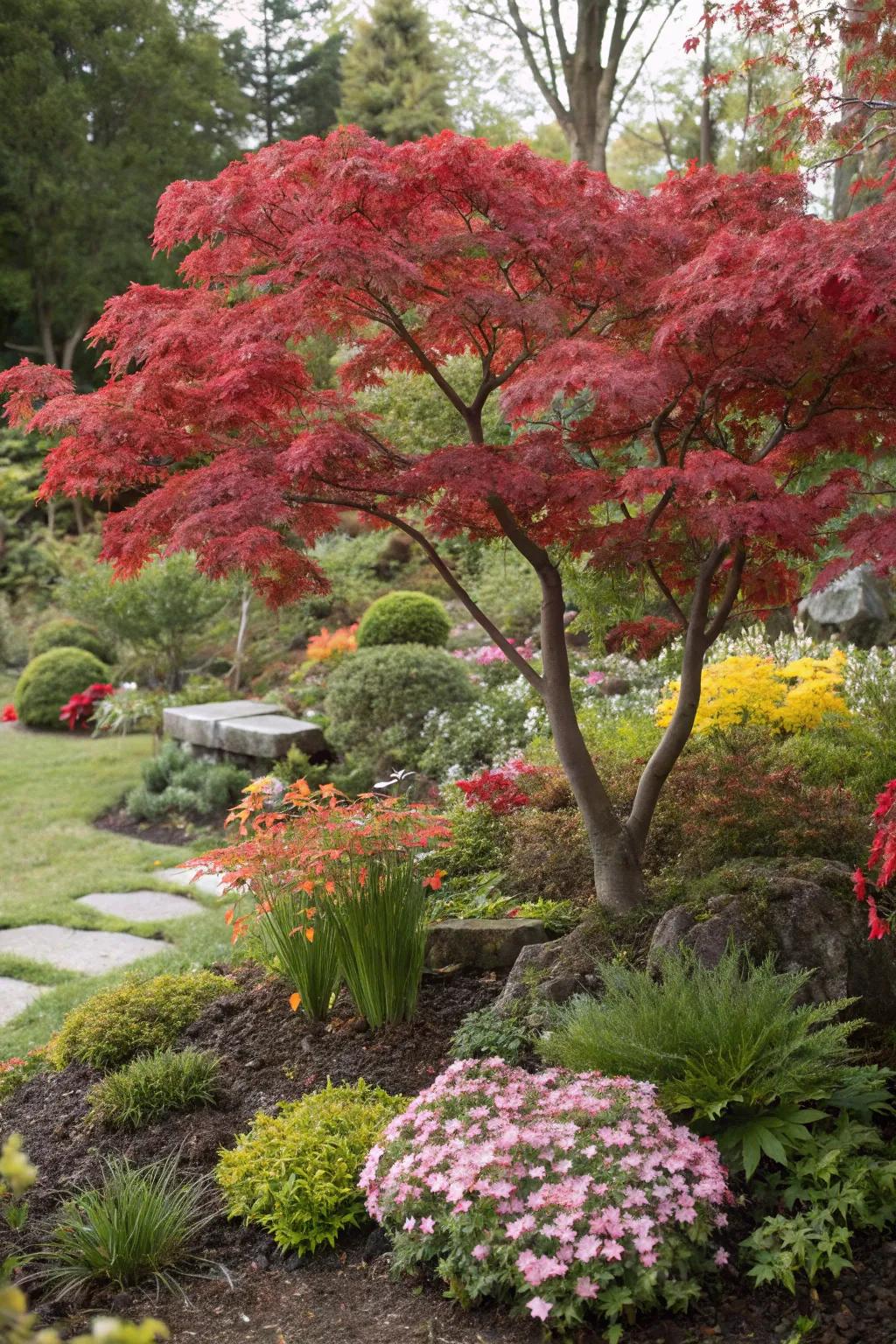
Match your Japanese maple to your garden’s color scheme for harmony. In my garden, coordinating colors creates a cohesive look.
A few choices to try:
- Red Garden Planters: Enhance your Japanese maple with coordinating planters, elevating the vibrant colors in your garden.
- Multicolored Outdoor Solar Lights: Illuminate your garden beautifully while matching the rich hues of your Japanese maple trees.
- Assorted Flower Bulb Mix: Plant these bulbs to harmonize your garden’s color scheme, complementing the maple’s striking tones.
5. Contrast with Greenery
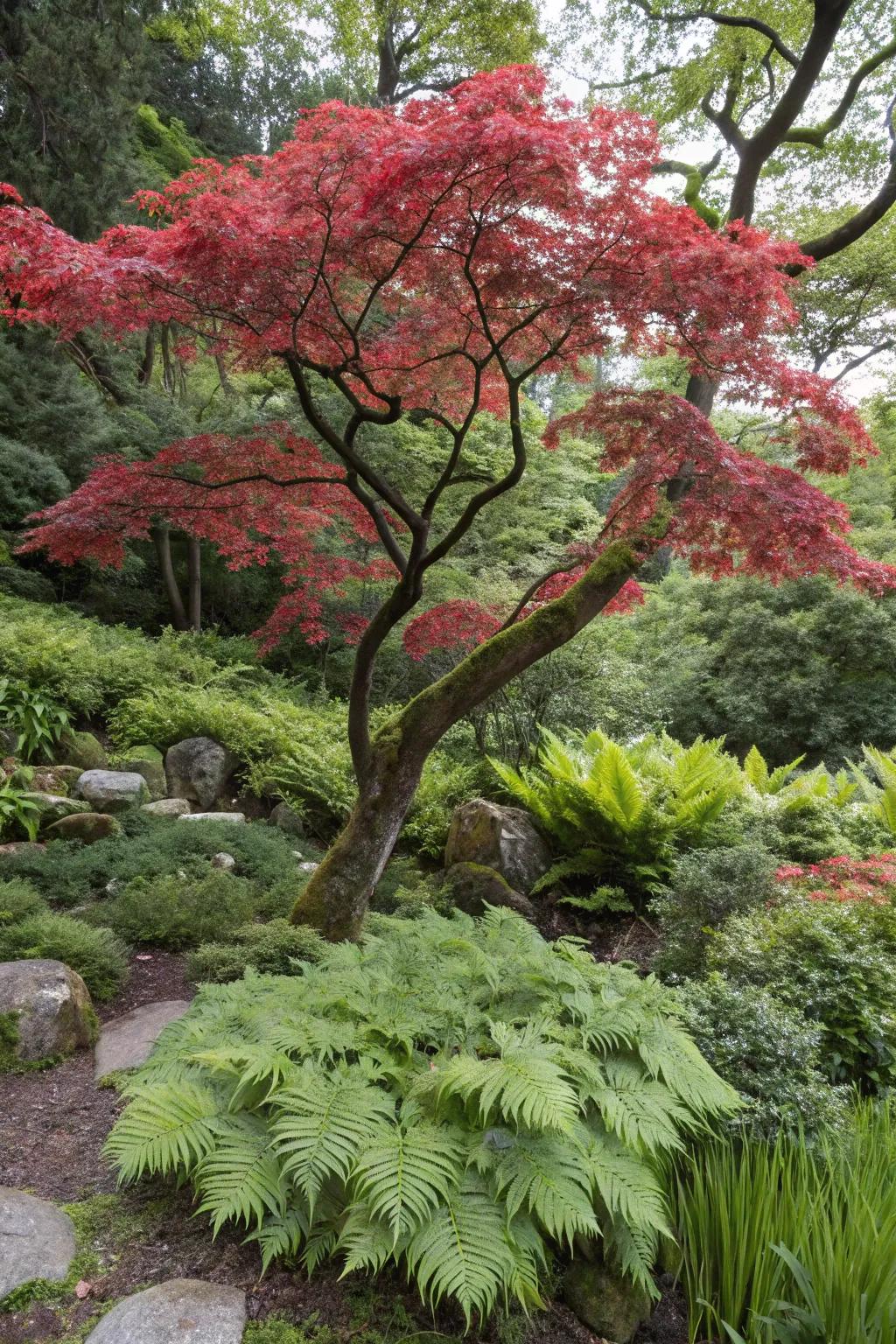
Pair the vibrant foliage of Japanese maples with lush green plants for a striking contrast. In my garden, this mix creates a dynamic and eye-catching landscape.
Check these products out:
- Japanese Maple Fertilizer: Enhance your Japanese maple’s growth and vibrancy with this specially formulated fertilizer.
- Shade Tolerant Green Plants: Add lush greenery to your garden with these easy-to-grow shade-loving plants.
- Pruning Shears: Maintain your garden effortlessly with durable pruning shears for precise trimming.
6. Pathway Elegance
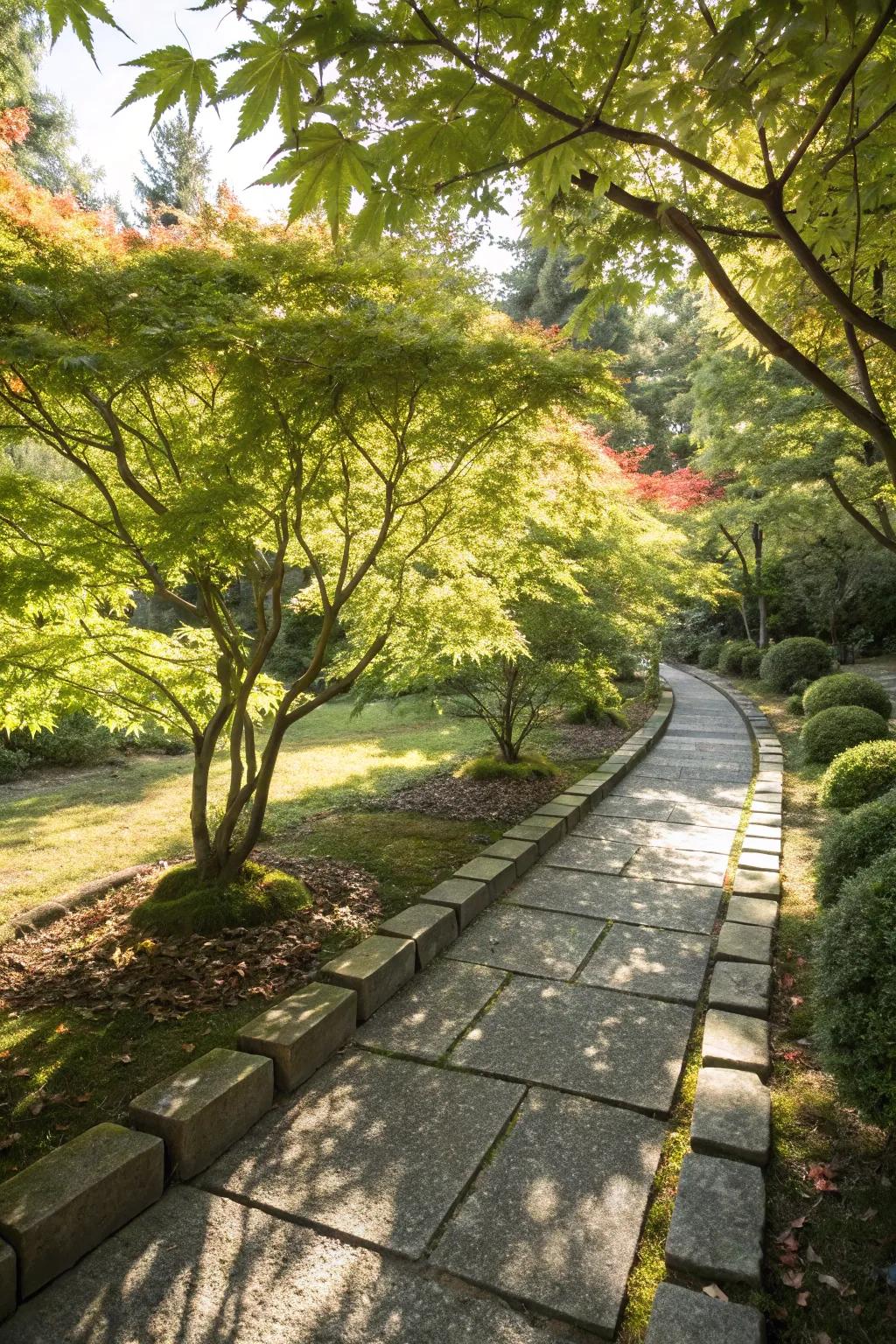
Line your garden pathways with Japanese maples to create an enchanting path. Their vibrant leaves offer a breathtaking view that guests will adore.
You might give these a try:
- Japanese Maple Tree Seeds: Grow your own Japanese maples for a spectacular pathway display guests will admire.
- Outdoor Pathway Lights: Illuminate your walkway with elegant lights for added safety and nighttime charm.
- Garden Pathway Pavers: Design a stunning path with durable pavers that complement your landscape beautifully.
7. The Art of Pruning
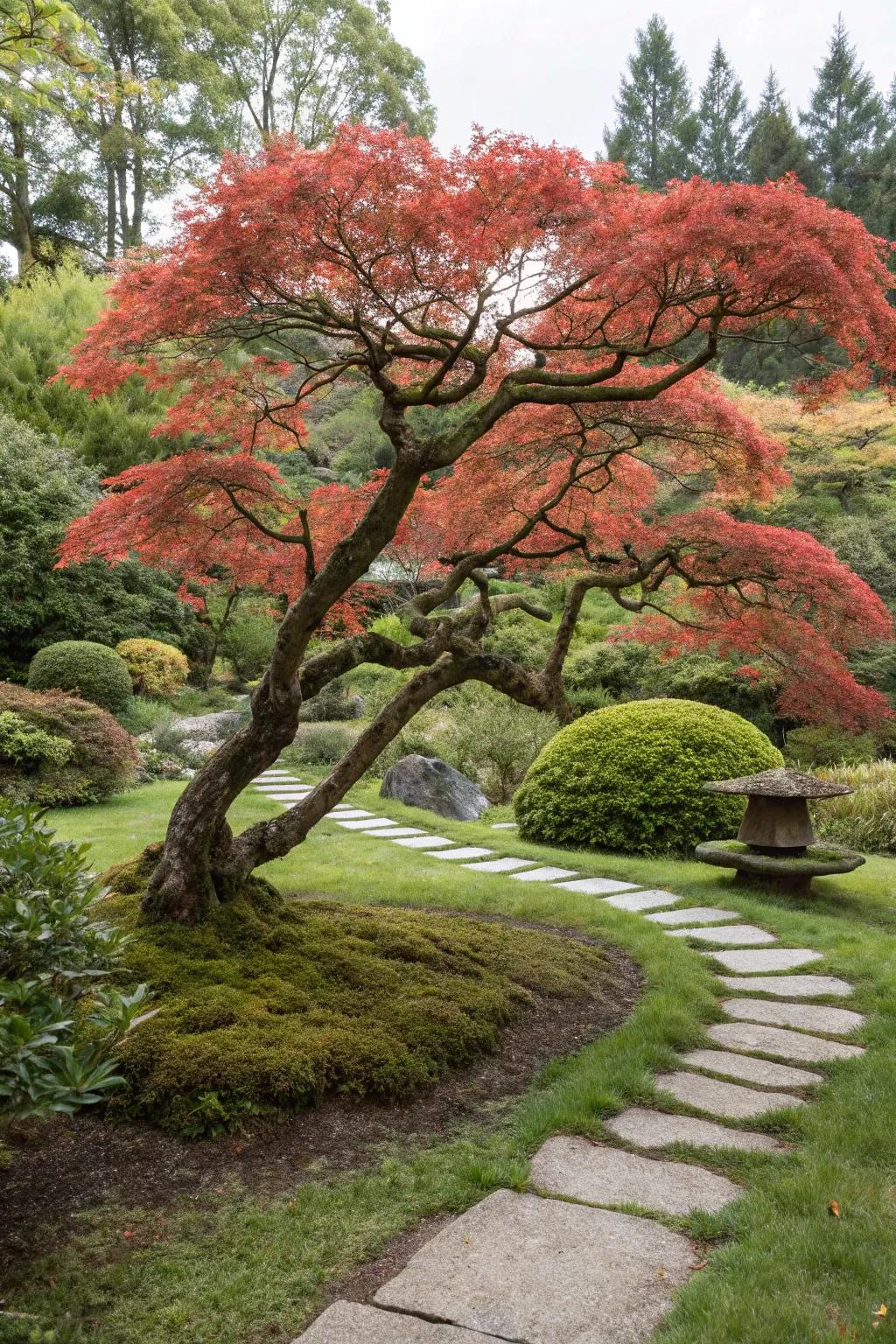
Prune Japanese maples to emphasize their graceful shapes. I find that careful pruning highlights their natural elegance and forms.
A few helpful options:
- Professional Bypass Pruning Shears: Enhance your Japanese maple’s beauty with precision cutting for a perfect natural shape.
- Adjustable Garden Pruning Ladder: Reach every branch effortlessly to maintain the magnificent form of your Japanese maple.
- Japanese Maple Fertilizer Spikes: Support vibrant growth and health with easy-to-use fertilizer for stunning foliage year-round.
8. Seasonal Showstoppers
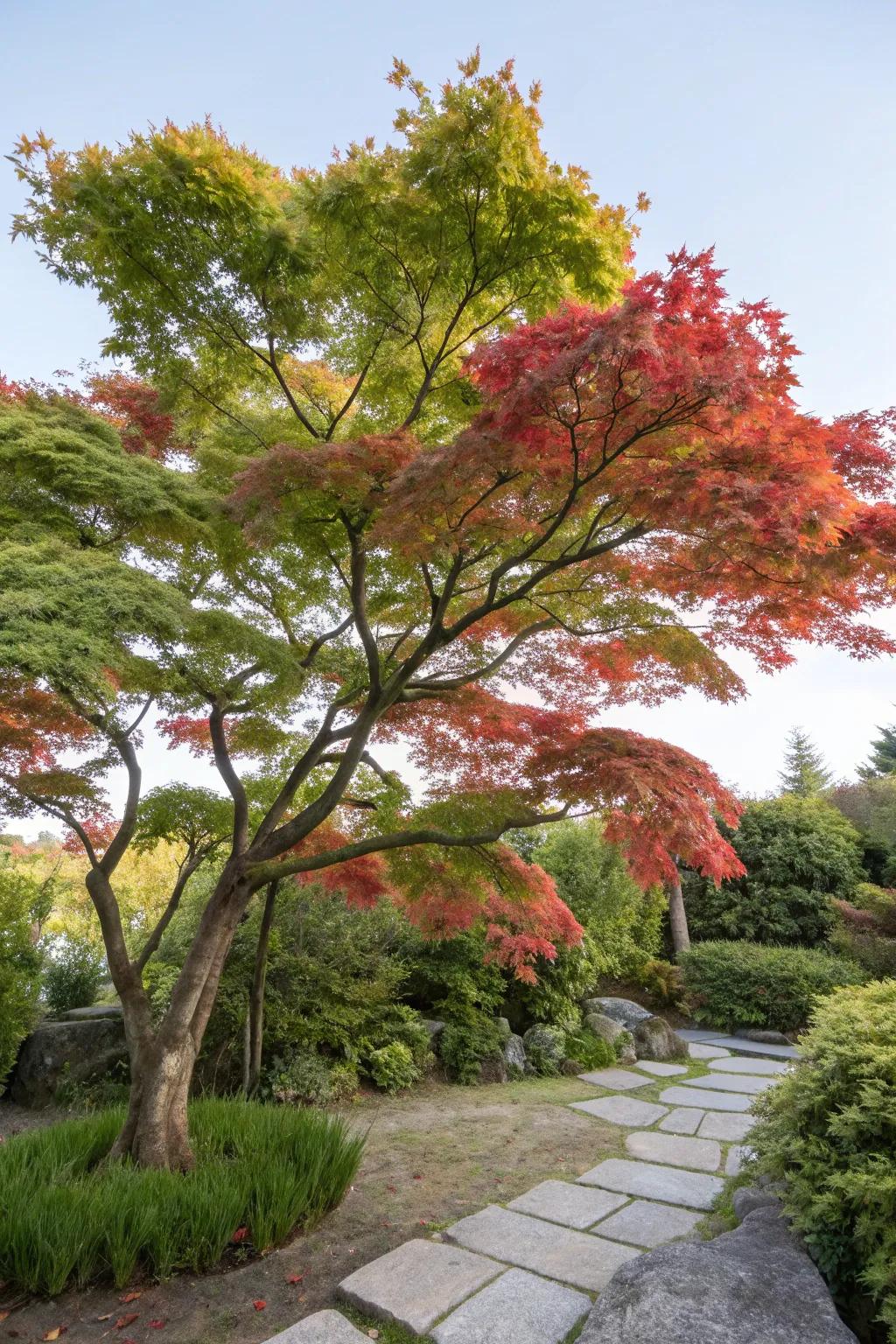
Enjoy year-round beauty with Japanese maples, whose foliage transforms with the seasons. It’s like having a new garden every few months!
Items that may come in handy:
- Garden Fertilizer for Japanese Maple Trees: Nourish your maples year-round with this specially formulated garden fertilizer. Enhance vibrant foliage today!
- Japanese Maple Pruning Shears: Keep your Japanese maples perfectly trimmed and healthy with these precision pruning shears.
- Decorative Garden Pathway Stones: Enhance your garden’s aesthetics and safety with beautiful, durable garden pathway stones.
9. Eco-Friendly Water Gardens
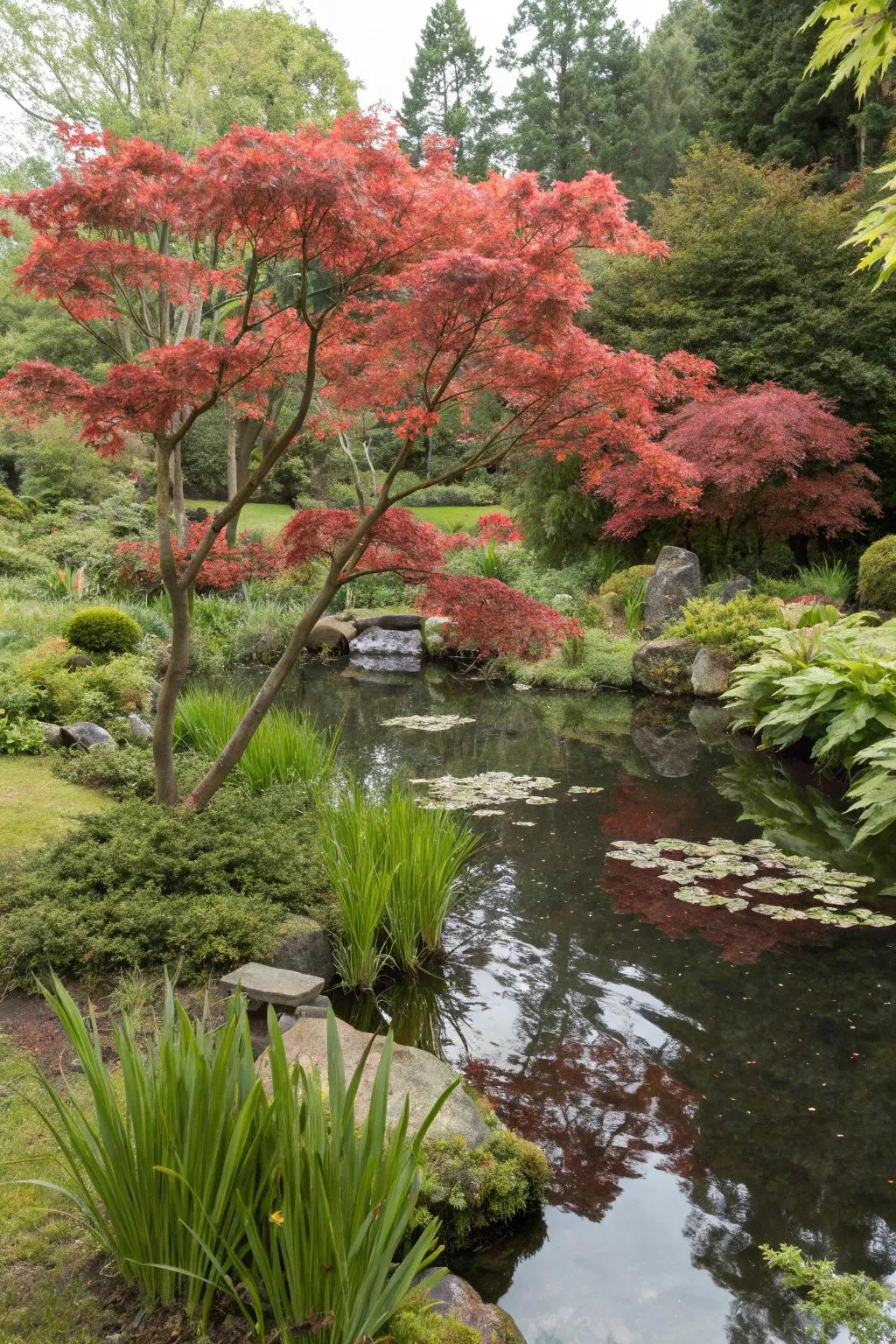
Integrate Japanese maples into water gardens for an eco-friendly approach. Their presence enhances the aquatic environment and supports local wildlife.
Some ideas to consider:
- Aquatic Plant Kit: Enhance your water garden with diverse aquatic plants to support local wildlife and biodiversity.
- Solar-Powered Pond Pump: Promote eco-friendly water circulation with this energy-efficient, solar-powered pond pump.
- Decorative Garden Stones: Add aesthetic appeal and natural beauty to your water garden with decorative garden stones.
10. Natural Privacy Screens
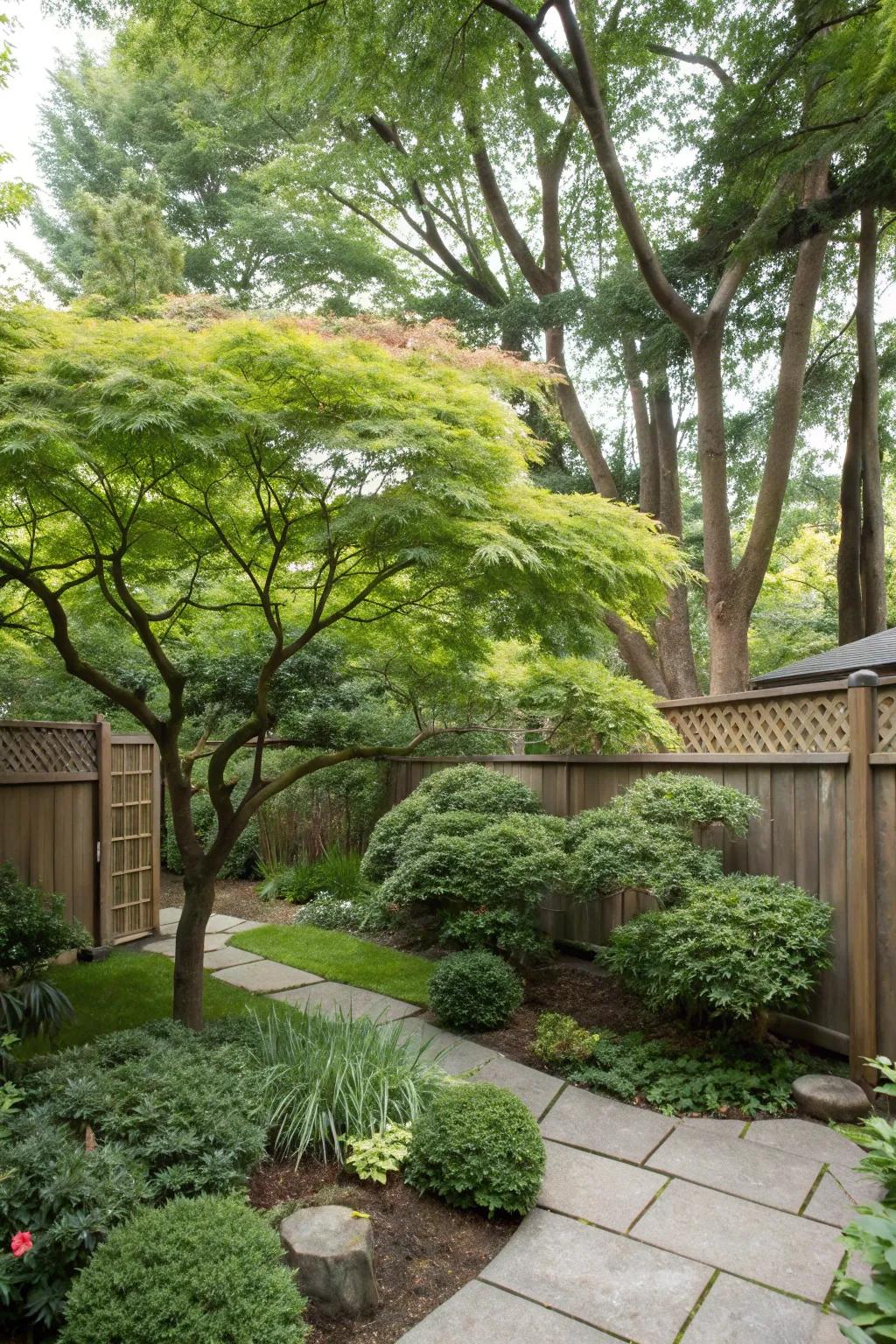
Use larger Japanese maples as natural screens for privacy in your yard. Their dense foliage provides a beautiful and functional barrier.
Check if these fit your needs:
- Outdoor Privacy Screens and Panels: Enhance your garden’s intimacy with stylish outdoor privacy screens for a tranquil retreat.
- Decorative Garden Fencing: Add elegance and security with decorative garden fencing, complementing your Japanese maple’s beauty.
- Solar Garden Lights: Illuminate your landscape with solar garden lights, highlighting your natural privacy screen’s allure.
11. Rock Garden Harmony
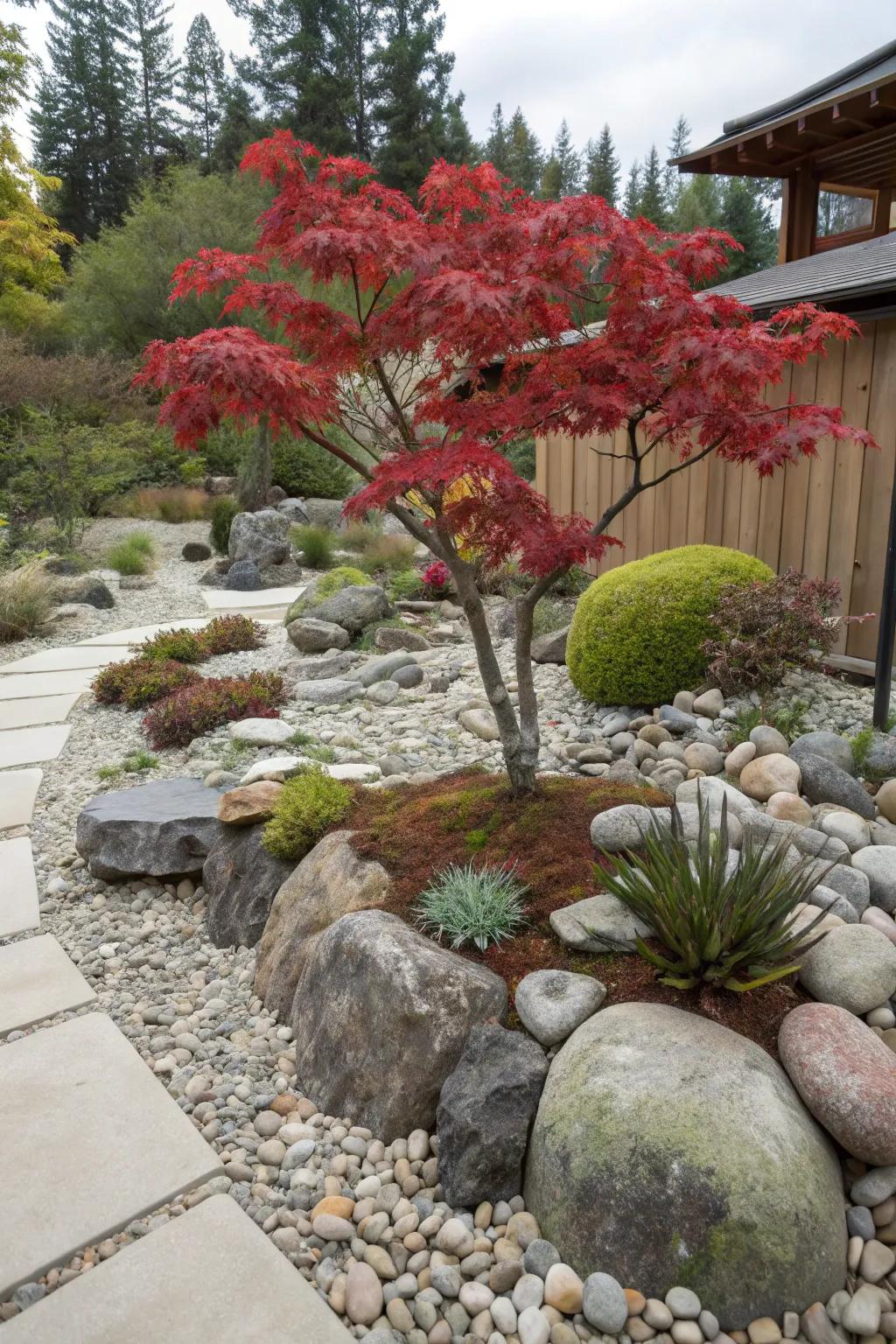
Incorporate Japanese maples into a rock garden for a natural and serene setting. The combination of rocks and maples creates a calming retreat.
Try these:
- Decorative River Rocks: Enhance your garden’s natural aesthetic with these smooth, decorative river rocks.
- Outdoor Garden Lanterns: Illuminate your rock garden with these stylish and durable outdoor lanterns for added ambiance.
- Japanese Maple Tree Fertilizer: Promote healthy growth in your maples with a specialized tree fertilizer designed for vibrant foliage.
12. Mulched Perfection

Surround the base of your Japanese maple with mulch for a tidy look that also retains moisture. It’s a simple tip that I always recommend to keep your garden looking polished.
Possibly handy products:
- Natural Hardwood Mulch: Enhance moisture retention and accentuate your Japanese maple with this high-quality natural hardwood mulch.
- Garden Edging Border: Define your garden space elegantly with durable and flexible garden edging borders that suit any landscape.
- Mulch Rake with Ergonomic Handle: Effortlessly spread mulch with an ergonomic rake, designed for comfort and efficient garden maintenance.
13. Nighttime Illumination
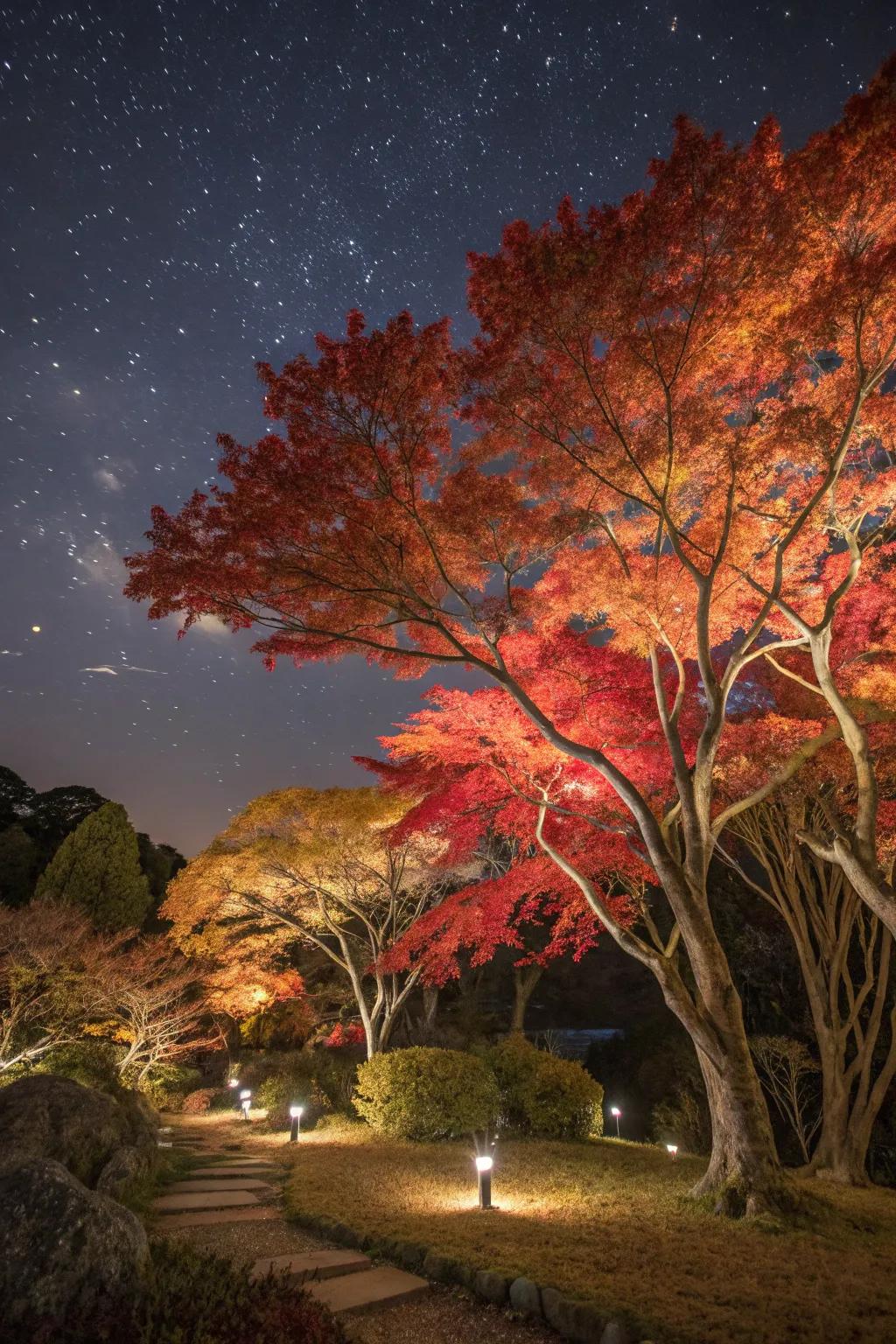
Illuminate Japanese maples with garden lights for a magical night-time display. I love how this simple addition transforms the garden’s evening ambiance.
Some handy options:
- Solar Garden Lights: Transform your garden with solar lights, adding eco-friendly elegance and charm to your evenings.
- LED Pathway Lights: Enhance garden pathways with LED lights, creating a safe and magical nighttime stroll experience.
- Outdoor Spotlights: Highlight your Japanese maples beautifully with outdoor spotlights, creating stunning visual effects.
14. Zen Garden Oasis
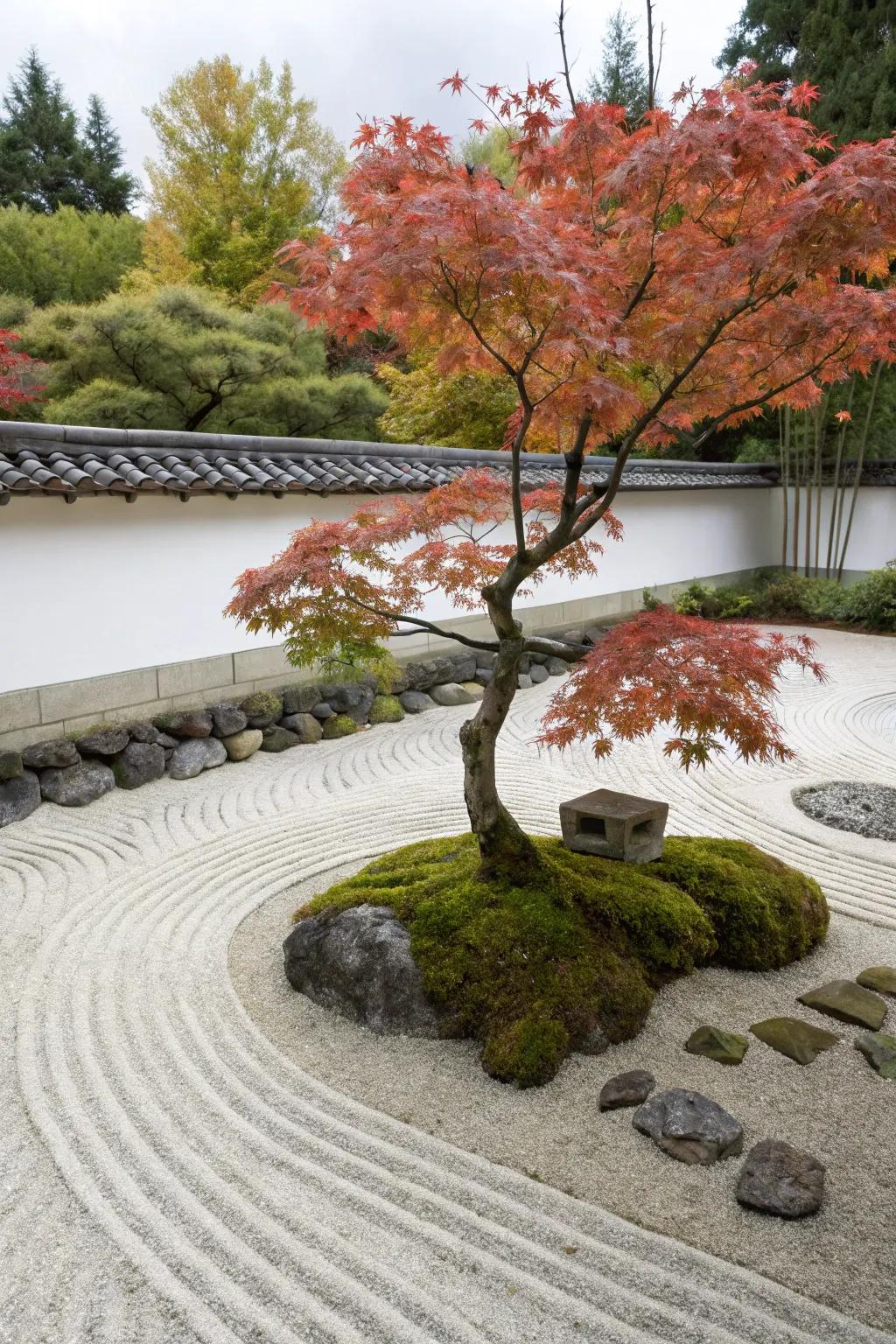
Create a Zen garden by pairing Japanese maples with sand and stone elements. This setup offers a tranquil escape right in your backyard.
Possibly helpful picks:
- Japanese Maple Tree: Enhance your Zen garden with a vibrant Japanese maple, perfect for serene landscapes.
- Zen Garden Sand: Create tranquil patterns in your garden using high-quality Zen garden sand.
- Decorative Garden Stones: Add elegance and style with decorative stones, enhancing your garden’s natural beauty.
15. Mixing Varieties
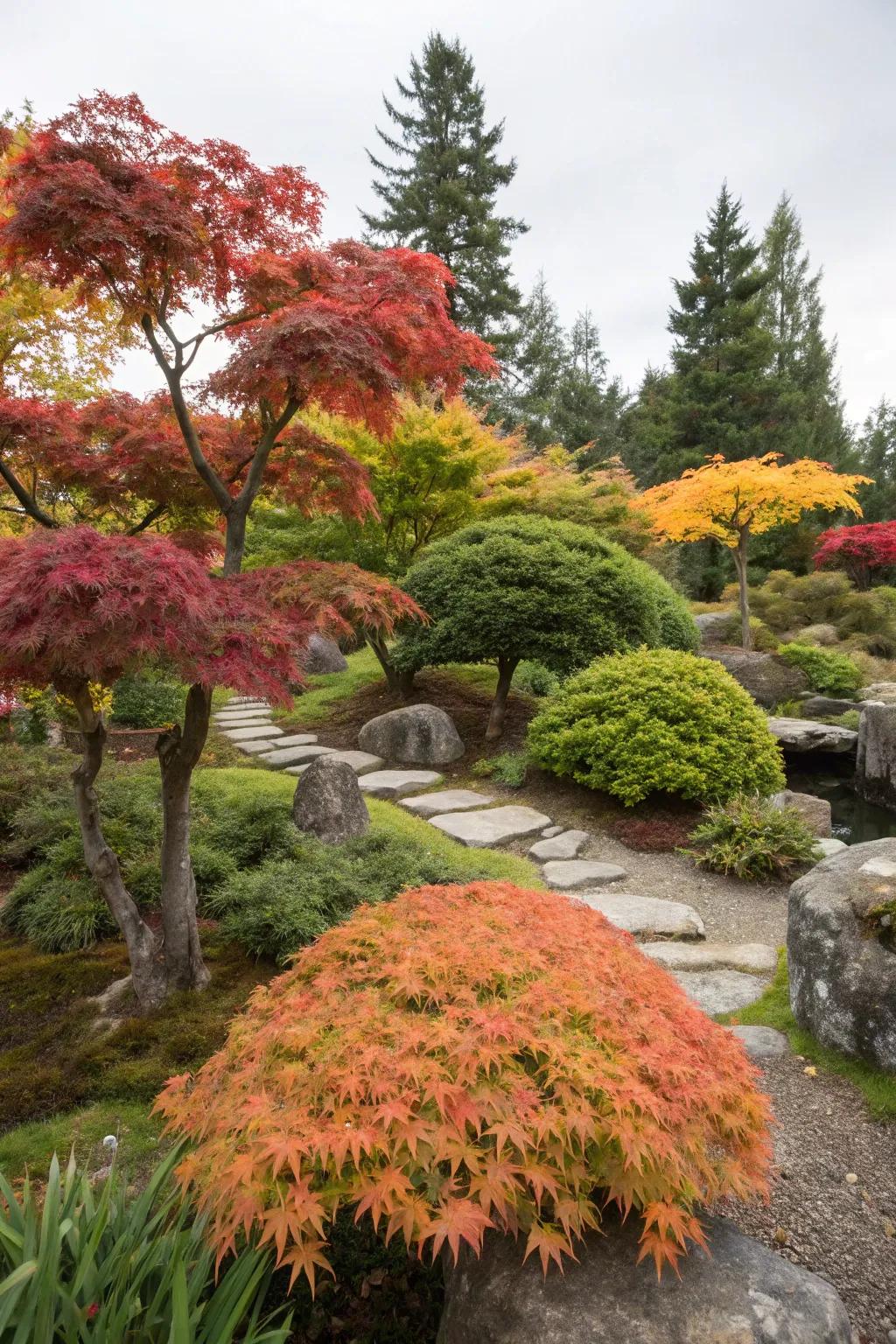
Mix different Japanese maple varieties for a striking display. The varied leaf shapes and colors add intrigue and diversity.
A few things you might like:
- Japanese Maple Tree Seeds: Plant diverse Japanese maple seeds to enhance your garden’s texture and color palette beautifully.
- Organic Fertilizer for Maple Trees: Boost growth and vibrant colors by applying this organic fertilizer to your maple trees regularly.
- Pruning Shears for Delicate Plants: Maintain the perfect shape and health of your maples using precision pruning shears.
16. Water Feature Companions

Plant Japanese maples near water features for a serene landscape. The reflection of the maples on water creates a mesmerizing effect.
Explore these options:
- Solar Water Fountain Pump: Elevate your garden with a solar fountain, adding movement and sparkle to tranquil waters.
- Outdoor LED Landscape Lights: Highlight your maples and water features with subtle LED lighting for nighttime beauty.
- Japanese Lantern Stone Statue: Add a touch of tradition near your water feature with a classic Japanese stone lantern.
17. Small Garden, Big Impact
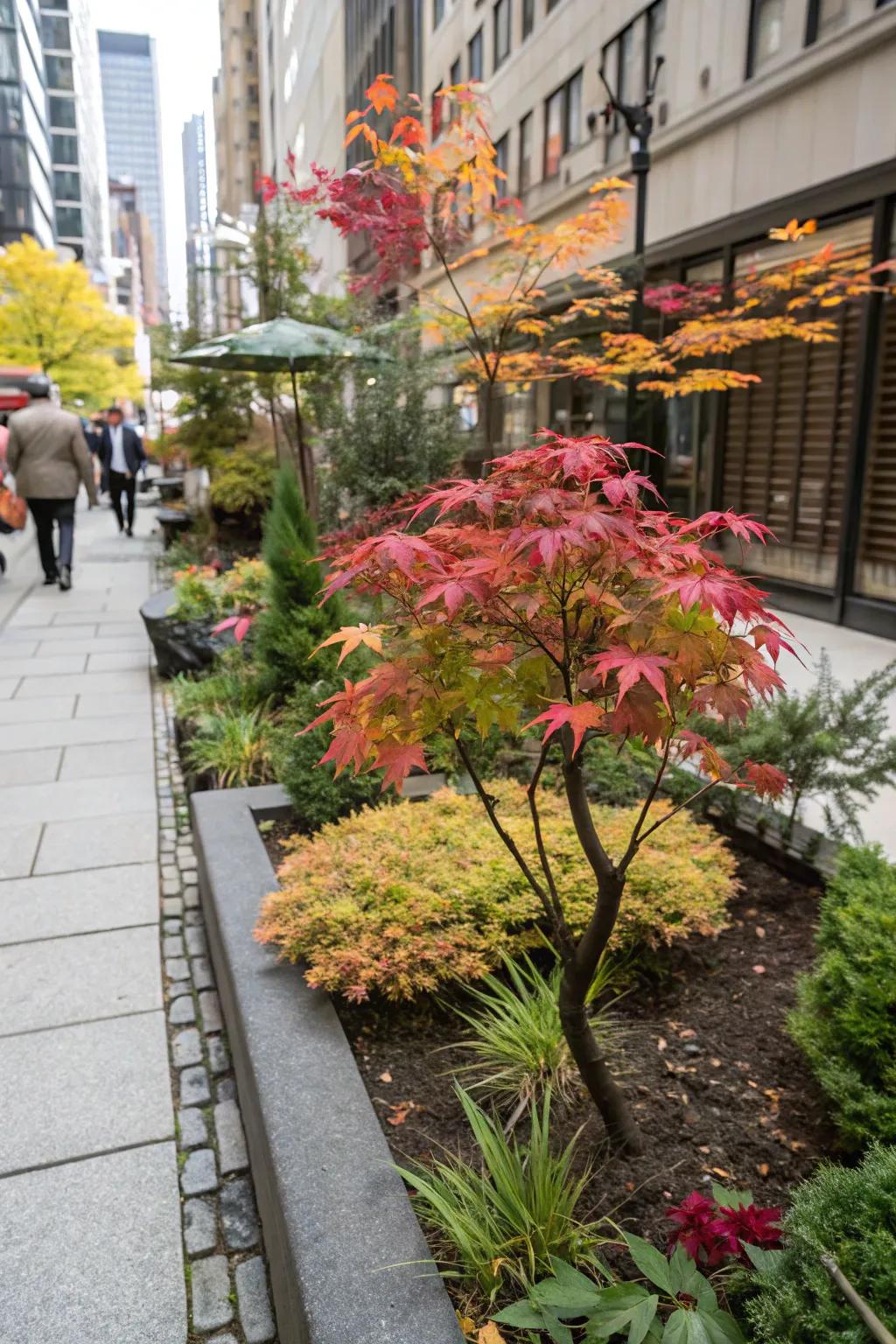
Even in small gardens, a Japanese maple can make a big impact. Choose dwarf varieties for compact spaces without sacrificing style.
A few relevant products:
- Dwarf Japanese Maple Tree: Enhance your garden with a stunning dwarf Japanese maple, perfect for compact spaces and style.
- Decorative Garden Planter: Add elegance to your garden with a stylish planter, ideal for showcasing your small trees.
- Colorful Garden Path Lights: Light up your garden path with vibrant lighting, creating an enchanting evening ambiance.
18. Creative Container Gardening
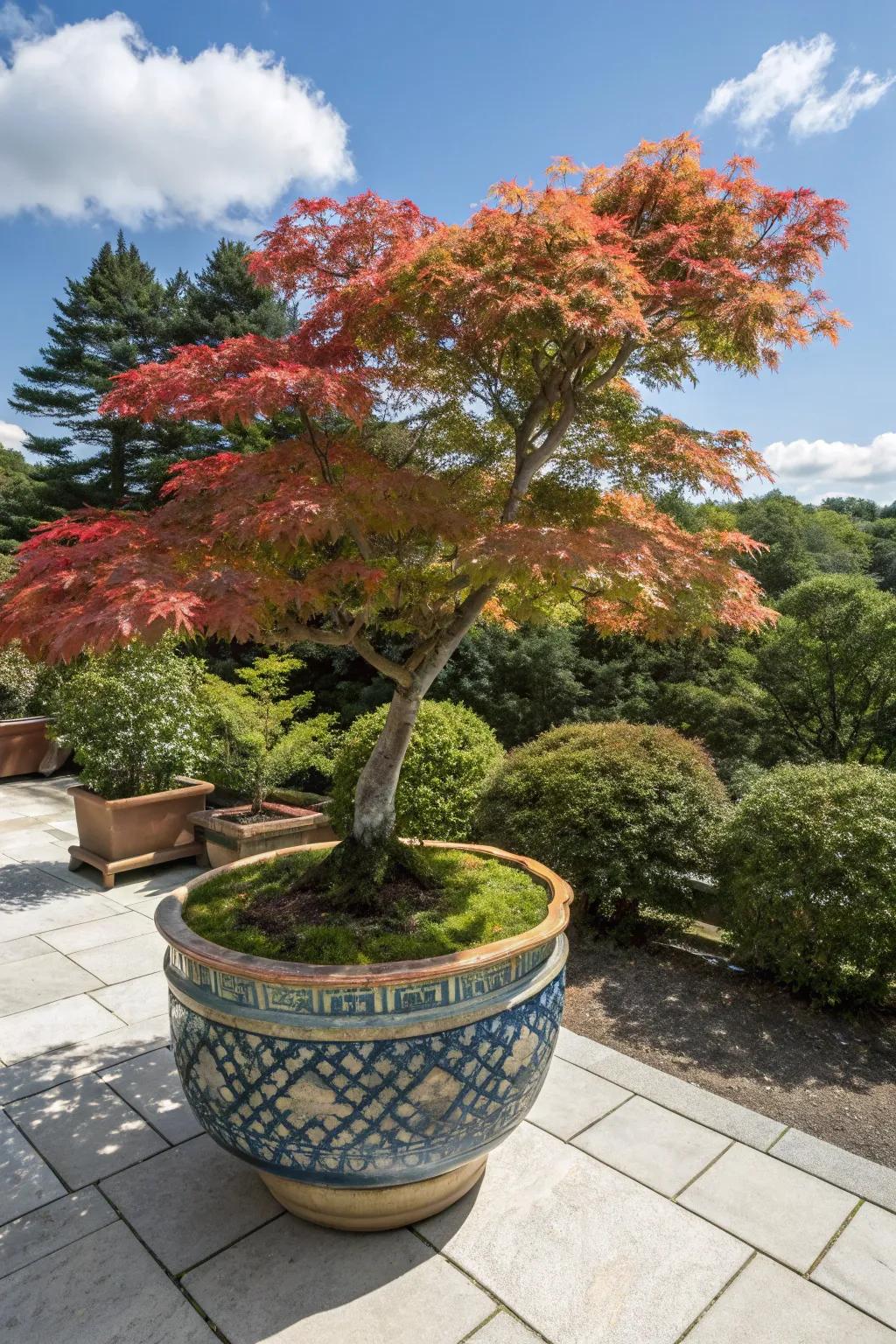
Grow Japanese maples in containers for a flexible garden design. Perfect for patios or small spaces, these trees thrive in pots with the right care.
Give these a look:
- Large Decorative Plant Pot: Enhance your garden with a stylish pot perfect for showcasing Japanese maples beautifully.
- Premium Potting Soil for Maples: Ensure optimal growth by using high-quality potting soil tailored for Japanese maples.
- Adjustable Drip Irrigation Kit: Keep your potted Japanese maple perfectly hydrated with an easy-to-install drip irrigation kit.
19. Modern Minimalist Design
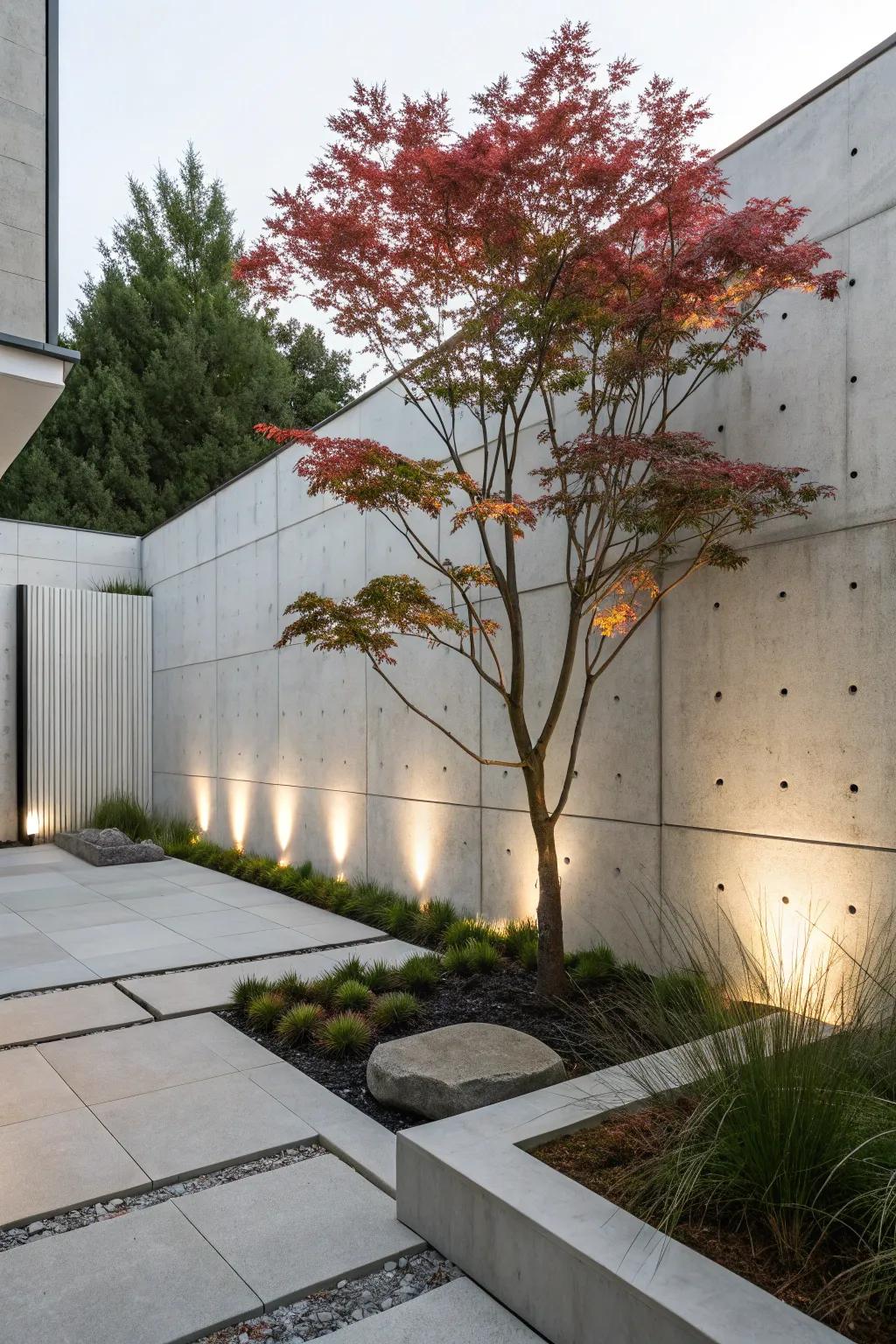
Embrace modern design by planting a solitary Japanese maple against a minimalist backdrop. This setup highlights the tree’s natural beauty.
Might be a good match:
- Outdoor LED Spotlights: Illuminate your Japanese maple and create stunning nighttime ambiance with these sleek LED spotlights.
- Minimalist Garden Planters: Enhance your landscape’s simplicity with these stylish, understated garden planters. Perfect for accent plants.
- Low-Maintenance Ground Cover Plants: Add texture effortlessly with these easy-care ground cover plants, ideal for a minimalist setting.
20. Integrating with Wildflowers
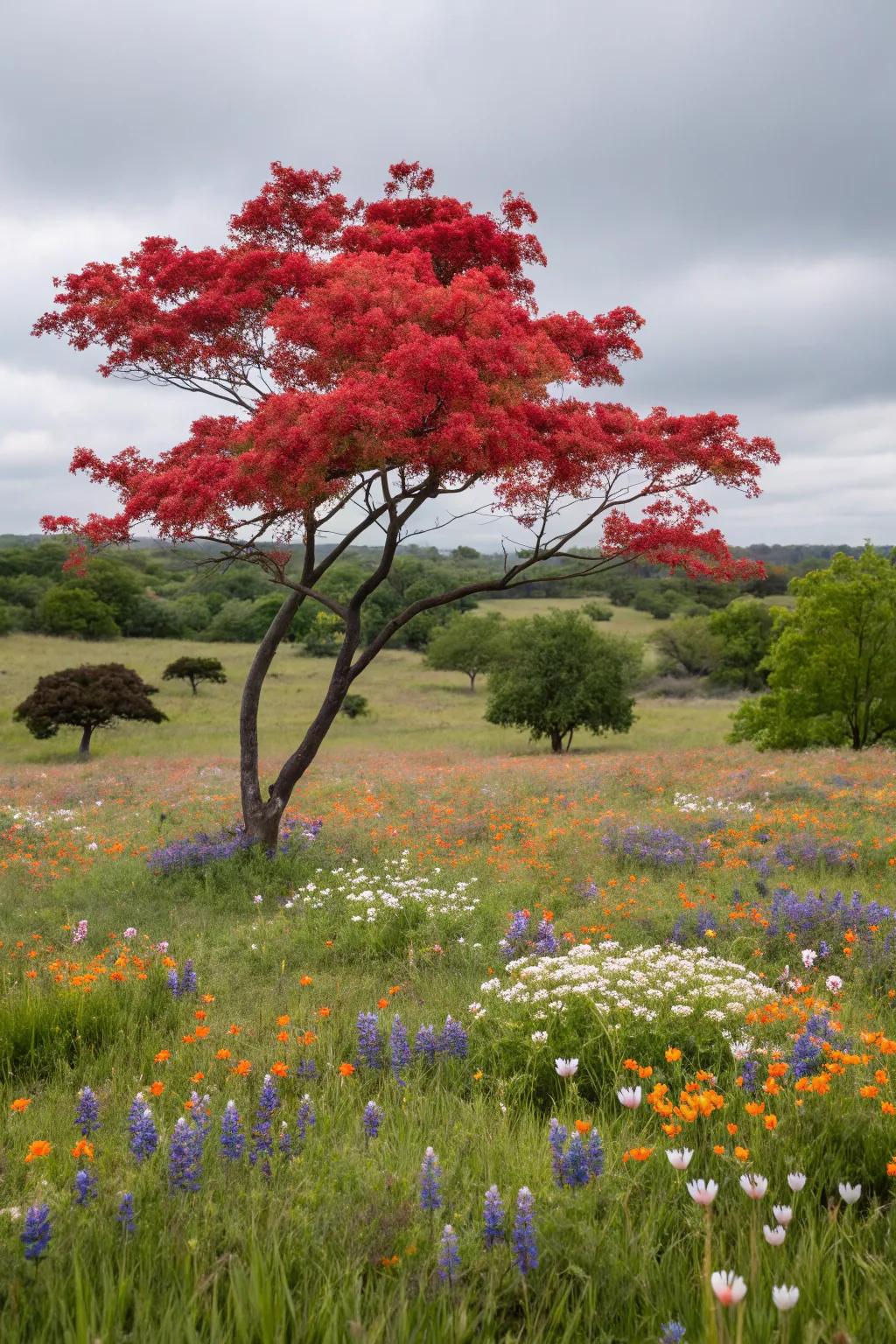
Pair Japanese maples with wildflowers for a natural, unkempt look. This combination is perfect for those who love a more organic garden style.
May just do the trick:
- Wildflower Seed Mix: Transform your garden with a vibrant wildflower seed mix, perfect for a natural, colorful landscape.
- Japanese Maple Tree Fertilizer: Boost the growth of your Japanese maple with this specialized, organic tree fertilizer for lush foliage.
- Garden Tool Set: Equip yourself with this essential garden tool set to maintain your wildflower and maple landscape.
21. Layered Plantings
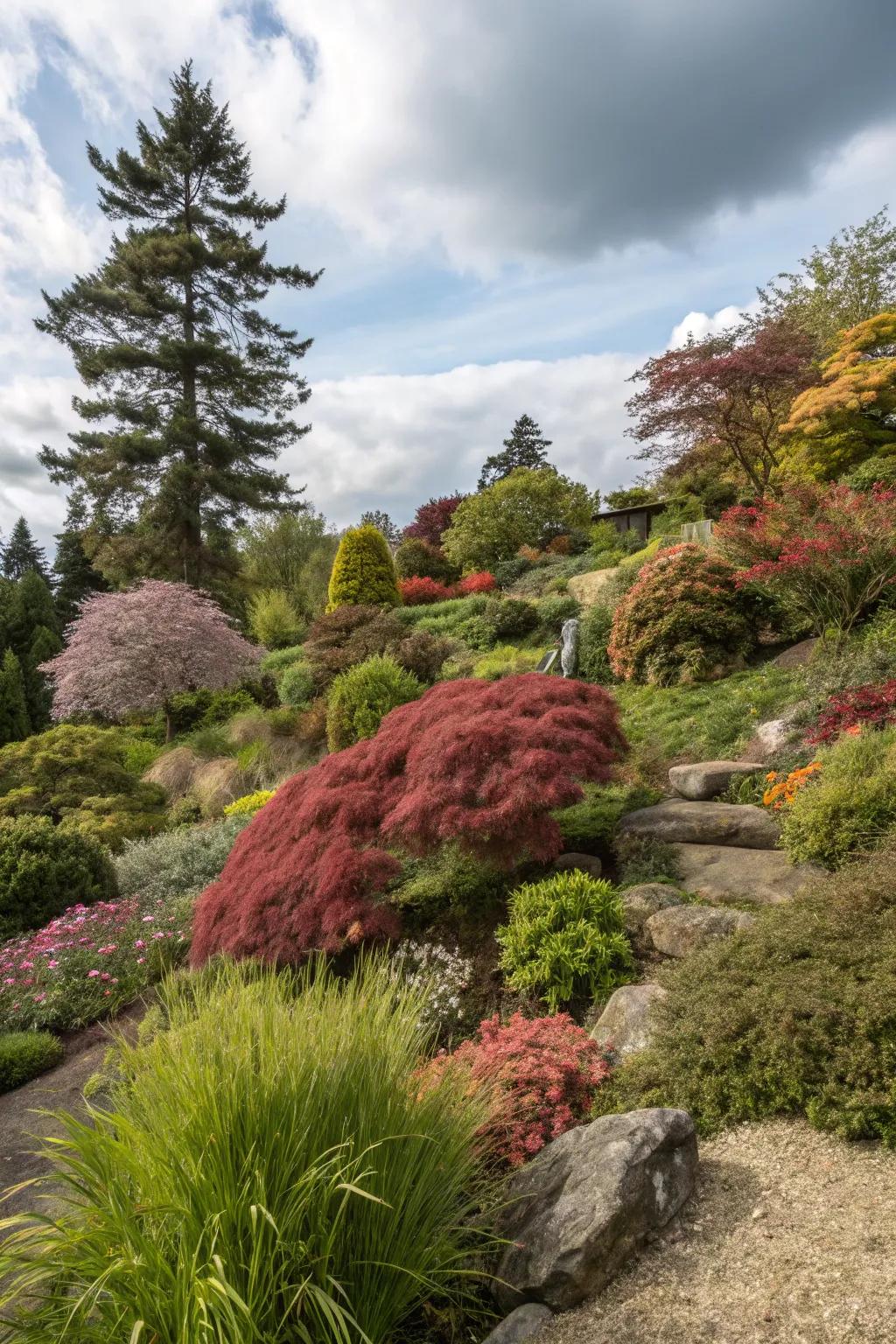
Combine Japanese maples with shrubs and ornamental grasses for a layered look. This approach adds depth and texture to any garden.
These products might be useful:
- Ornamental Grasses Assortment: Enhance your garden’s texture with a variety of ornamental grasses. Create a lush, layered effect.
- Shrub Mix for Landscaping: Add depth to your garden with a shrub mix perfect for layered landscaping. Enjoy diverse colors.
- Japanese Maple Tree: Transform your garden’s ambiance with an elegant Japanese maple. Enjoy its vibrant seasonal hues.
